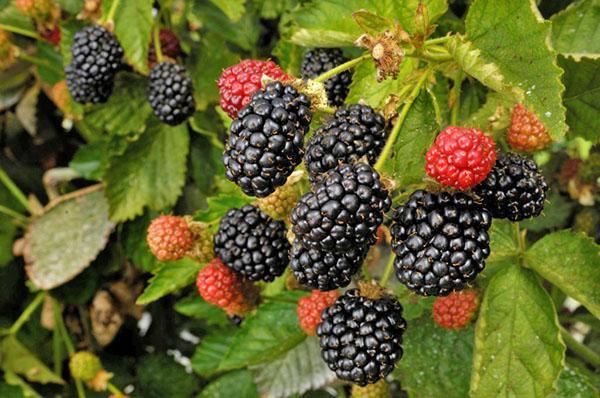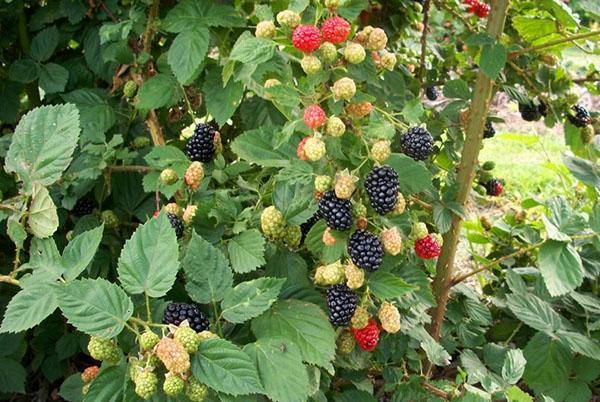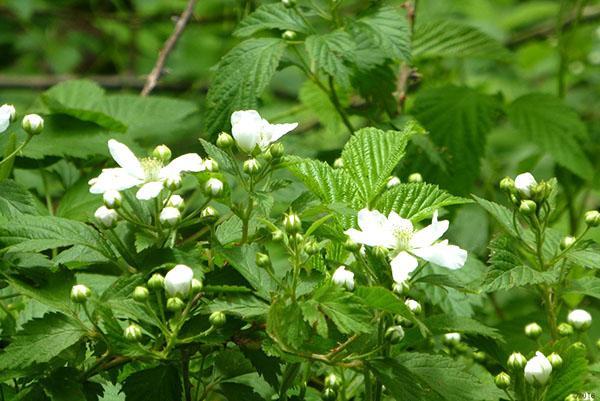Photo and description of the garden variety of blackberry Thornfree
 Nature gave the blackberry not only delicious berries, but also thorns that interfere with harvesting and care. One of the first thornless plants was the Thornfrey blackberry, the description of the variety and the photo of which will be of interest to summer residents in many Russian regions, as well as farmers engaged in industrial cultivation of crops.
Nature gave the blackberry not only delicious berries, but also thorns that interfere with harvesting and care. One of the first thornless plants was the Thornfrey blackberry, the description of the variety and the photo of which will be of interest to summer residents in many Russian regions, as well as farmers engaged in industrial cultivation of crops.
Today, gardeners have at their disposal several dozen varieties and hybrids that are completely devoid of thorns. They are high yielding, drought tolerant and disease-free. However, the Thornfrey blackberry variety, bred in 1966, still enjoys well-deserved love and respect.
Thornfree Studless Blackberry Description

Blackberries can be creeping or bushy. As a rule, garden varieties today are quite powerful shrubs with erect or lodging shoots.
This makes it more convenient to care for plantings, control growth and harvest. According to the description and photo, the Thornfrey blackberry is a sturdy bush with long, half-lying shoots that can grow up to 4–5 meters without pruning. Fruiting plantings with proper agricultural technology have a height of 15-200 cm, the diameter of the shrub reaches 200 cm.
Created as a commercial, for industrial berry cultivation, the thornless variety stands out for its strong, tough shoots with well-visible edges. At the surface of the ground, the diameter of the dark green shoot reaches 30 mm, there are no thorns along the entire length. The dense, textured leaves are divided into three or five parts and are deep green in spring and summer. By autumn, the foliage turns yellow.
 The flowering of the Thornfrey garden blackberry begins in the first half of June. Bisexual flowers of white or slightly pink hue have a delicate aroma, collected in racemic inflorescences with gradually opening buds. In favorable weather conditions, the self-pollinating variety perfectly forms and holds the ovary.
The flowering of the Thornfrey garden blackberry begins in the first half of June. Bisexual flowers of white or slightly pink hue have a delicate aroma, collected in racemic inflorescences with gradually opening buds. In favorable weather conditions, the self-pollinating variety perfectly forms and holds the ovary.
Thornfree Garden Blackberry

Under the weight of ripening berries, hard shoots bend so that the brushes are almost at the ground level. Ripening begins in August and lasts until mid-September.
Berries of oval or wide-conical shape have:
- weight from 5 to 8 grams;
- sweet taste with pleasant sourness;
- black with a violet-bluish tint, becoming dull at the stage of maturation;
- aroma characteristic of garden blackberries.
 In the photo and from the description of the Thornfrey blackberry, it can be seen that the fruiting of this variety is not massive, but gradual. However, this does not detract from the dignity of a very productive variety, since up to 30 ovaries can form on one brush, and about 120 berries ripen on the entire shoot. During the season, the bush gives up to 15 kg of universal berries, equally suitable:
In the photo and from the description of the Thornfrey blackberry, it can be seen that the fruiting of this variety is not massive, but gradual. However, this does not detract from the dignity of a very productive variety, since up to 30 ovaries can form on one brush, and about 120 berries ripen on the entire shoot. During the season, the bush gives up to 15 kg of universal berries, equally suitable:
- for fresh consumption;
- for making homemade fruit and berry preservation;
- for drying;
- for freezing.
According to experts, the tasting qualities of the Thornfrey blackberry variety is 4.4 points out of 5 possible. At the time of collection, juicy drupes contain:
- 9.3% dry matter;
- 0.9% pectins;
- 5.5% sugars;
- 0.8% organic acids.
For 100 grams of berries there are 10 mg of ascorbic acid and up to 300 mg of P-active substances.
Advantages and disadvantages of the Thornfrey blackberry variety
 Delicious and healthy blackberries, ripening, acquire an alluring aroma, but also noticeably soften. Gardeners consider this disadvantage to be the main one in the Thornfrey variety.
Delicious and healthy blackberries, ripening, acquire an alluring aroma, but also noticeably soften. Gardeners consider this disadvantage to be the main one in the Thornfrey variety.
To preserve quickly crumpled berries, picking begins a few days before full ripeness.
This technique allows you to preserve the transportability of the berries, but at the same time their aroma is slightly weaker than possible, and the acid is felt in the taste, which does not detract from consumer qualities.
Excellent taste is a clear, but not the only advantage of the variety. In addition, Thornfree's studless blackberry is worth paying attention to thanks to:
- high and stable yield;
- lack of thorns that interfere with the collection and care of bushes;
- resistance to common diseases, for example, stem cancer, anthracnose, rust;
- universal purpose of berries.
The disadvantages of the Thornfrey blackberry variety are much less. These include the short shelf life of ripe berries and their low transportability, as well as frost resistance at 18 ° C.
In conditions of the middle lane, shoots must be covered, which is very difficult to do with rigid, recalcitrant stems.
Planting and caring for Thornfree blackberries
 All varieties of garden blackberries can be classified as unpretentious crops. Shrubs perfectly resist pest attacks and are rarely affected by diseases. If the weather permits, many berries are tied on the shoots. The main condition for success is to provide light soil for planting Thornfree Blackberries and care, which consists in watering, feeding and pruning plants.
All varieties of garden blackberries can be classified as unpretentious crops. Shrubs perfectly resist pest attacks and are rarely affected by diseases. If the weather permits, many berries are tied on the shoots. The main condition for success is to provide light soil for planting Thornfree Blackberries and care, which consists in watering, feeding and pruning plants.
Fast-growing blackberry shoots should receive enough nutrition, moisture and air, therefore, a site with a loose, well-drained soil with a pH of 5.5-6.5 units is allocated for planting. Culture loves light, the abundance of which determines the quantity of berries and their quality. Although the shoots grow up to 5 meters long, they are rarely affected by the wind. The Thornfrey blackberry variety is not afraid of drought, but with additional watering, especially after flowering, you can expect an increase in yield and an increase in berry weight. At the same time, the plantings are fed.
Due to the growth of shoots, which complicates care, pruning Blackberry Thornfree is a must. This agrotechnical technique helps to manage the bushes in autumn, when it is time to shelter the berry from frost. Low pruning of replacement shoots helps tame blackberries, they branch and become more plastic. Another method involves digging bushes and tipping them on their side. In the spring, the plants are returned to their place.
Thornfree thornless blackberry can be propagated using green cuttings or by means of root cuttings that appear when the roots are damaged.
1.Very sour berries. 2.What is it: illness or the sun is to blame (we live in anapa)?
According to personal observations, this year blackberries gained sweetness only at the end of ripening, when the berry practically fell. The second harvest is less sweet. This could be due to a sudden change in weather. Rains followed bright sunny days. Sun before lunch and rain in the afternoon.